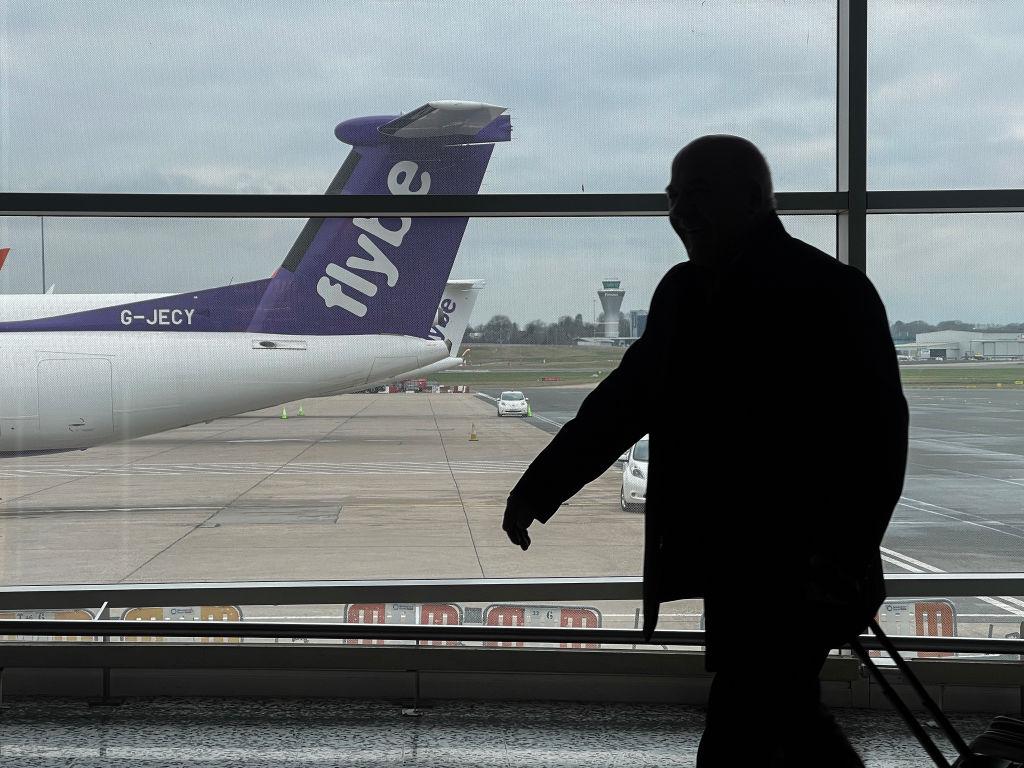
Flybe entered administration and ceased trading on Jan. 28, less than a year after returning to the skies following a previous collapse.
Analysis of schedules data provided by OAG shows that almost 300 flights were due to be operated this week by the UK regional airline across 17 routes. The airline had been serving 10 airports in England, Scotland and Northern Ireland, as well as international points Amsterdam and Geneva.
In total, some 22,776 departure seats had been scheduled to operate across its network during the week commencing Jan. 30. About 76% of the carrier’s capacity was on domestic routes in the UK.
Overall, Birmingham, England-based Flybe would have accounted for about 4.1% of the total UK domestic capacity available this week, making it the fifth largest operator behind easyJet, British Airways, Loganair and Aer Lingus.
https://infogram.com/rou-uk-capacity-0130-1h984woryrkld6p?live
Looking at Flybe’s schedule, almost 5,500 departure seats had been slated to operate from Belfast City (BHD), making it the airport the largest in the airline’s network. The carrier accounted for around 19% of total capacity from the airport, across 70 weekly flight departures.
However, the airport is less exposed than when the previous incarnation of Flybe collapsed in March 2020. At that time, Flybe accounted for about 67% of Belfast City’s total capacity and 79% of its frequencies.
Commenting on the latest administration, Belfast City CEO Matthew Hall said it was “disappointing and unexpected news.” But he added that of the 10 destinations served by Flybe from the Northern Ireland airport, eight are available with other carriers.
Birmingham (BHX) was the second largest airport in the carrier’s schedule with 3,666 departure seats planned for this week, followed by London Heathrow (LHR) with 3,354. Amsterdam (AMS) was the fourth largest with 2,574 seats scheduled, and Edinburgh (EDI) was fifth with 1,482.
https://infogram.com/rou-flybe-airport-capacity-0130-1hnq410eg8oop23?li…
Of the 17 routes served by Flybe prior to its collapse, Birmingham-Belfast City and Belfast City-London Heathrow were the largest by capacity, each totaling 2,184 weekly seats. Analysis of the airline’s network reveals that it faced direct competition on 12 of the services it offered.
The five routes where Flybe was the sole operator comprised East Midland (EMA)-Amsterdam; Belfast City-East Midlands; Belfast City-Newcastle (NCL); Cornwall Newquay (NQY)-London Heathrow; and Cornwall Newquay-Manchester (MAN).
Scottish regional carrier Loganair last served the Cornwall Newquay-Manchester sector in October 2022 but has already confirmed plans to resume a daily flight from Feb. 10, while easyJet will also fly the route from the start of the summer 2023 season.
In addition, easyJet serves the Belfast-Newcastle market from Belfast International (BFS), and Eastern Airways operates flights to London Gatwick (LGW) from Cornwall Newquay. Ryanair is also due to serve NQY-London Stansted (STN) this summer.
https://infogram.com/rou-flybe-network-0130-1h1749vgezr9l6z?live
Earlier this month, Flybe unveiled a summer schedule and said it would offer two new routes from its Birmingham base. They were due to be Aberdeen (ABZ) and Bergerac (EGC) in France. The airline also planned to bring back seasonal flights to French destinations Avignon (AVN) and Brest (BES).
Flybe’s planned summer 2023 schedule comprised some 1.2 million departure seats and more than 14,700 flights. In total, it intended to operate 23 routes, with more than 300,000 seats scheduled to depart from Belfast City.
The airline was led by CEO Dave Pflieger, the former CEO of Alaska-based regional airline Ravn Air. It operated a fleet of eight De Havilland Canada Dash 8-400 aircraft.
David Pike from insolvency firm Interpath Advisory, one of the joint administrators of Flybe Limited alongside Mike Pink, said the collapse was a “real setback in terms of the UK’s regional connectivity at a time when infrastructure and leveling up is high on the agenda.”
He added: “Unfortunately, the company had to withstand a number of shocks since its relaunch, not least of which was the late delivery of 17 aircraft which it needed for its schedule, and which has severely compromised both the airline’s capacity and its ability to remain competitive.”
It is understood that 277 of Flybe’s 321 staff have been made redundant, with the likes of easyJet, Ryanair and Wizz Air expected to snap up available staff. Wizz Air has already announced plans for online and in person recruitment events for former Flybe cabin crew and pilots.
The old Flybe failed in March 2020 and its brand and assets were sold to Thyme Opco, a business linked to hedge fund Cyrus Capital. New York-based Cyrus Capital was previously part of a consortium that owned the airline alongside Virgin Atlantic and the now-defunct Stobart Air.
The latest collapse will have a less severe impact on UK connectivity than the failure of the previous incarnation in early 2020. Flybe had been the largest operator of domestic flights in the UK during 2019 with a 38.2% share of departures. This put the airline ahead of easyJet on 19.8% and British Airways on 16.9%.
In addition, Flybe was the second largest provider of domestic capacity. There were 28.79 million domestic departure seats in the UK during 2019, of which the carrier offered 8.3 million of them, equating to 28.9%.
